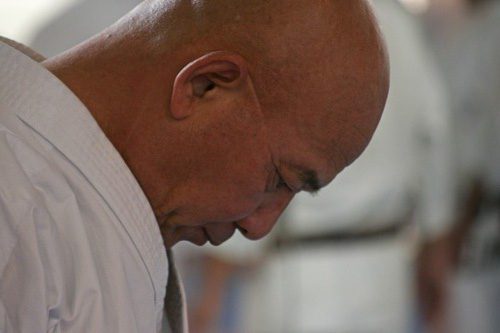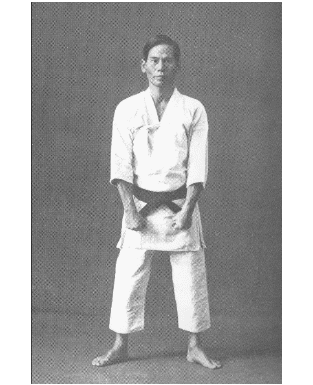I recently received a very handsome e-mail from a very handsome reader.
It goes (slightly abbreviated):
“Jesse-san! Maybe you would write some stuff about Numb Chucks? (nunchaku, but for the longest time, I thought it was “numbchucks” cause they’d make you numb if you hit yourself while chucking them).
Growing up in the 80s, I “learned” to swing my nunchucks, and I can do all kinds of flashy moves, both hands, two pair etc. Last week I even tried using them again. I went “Whish, swish, flish, flash, swish swish swish, whir, whir, slap.” And caught them, perfect, just like I practiced a hundred thousand times as a wanna-be eighth grade ninja boy.
But I don’t know what any of it really means!
I can swing them, but I would not dare try to strike anything for fear they’d bounce off and smack me!
I know you can use them for trapping limbs or weapons? How? I did some kata with them in my hand the other day, and tried to imagine applications. I was confused!
I must ask one of the instructors soon, but they don’t have weapons classes anymore. And I think most of their numbchuck are for exhibition, because they use these super light aluminum chucks with an extra short chain, and an extra chain link inside, so they rattle.
Kinda neat, but kinda aggravating too.”
Don’t fear, dear good-looking friend – The Chuckmeister is here!
One of the most common questions we receive as Karate practitioners must surely be how to use the nunchaku. Or “numb chucks”.
And when most of us get that question (trust me, sooner or later you will get it) what do we reply? “Oh, that’s easy! But… but I can’t show you, because you are not advanced enough to learn yet” we say, hinting that we are indeed Bruce Lee reincarnated. Or perhaps we reply “in Karate we never use weapons, that’s just for the movies”.
But haven’t you, in the back of your mind, ever thought “well, how DO I use a nunchaku?”.
Because, like my friend above, most people have no idea how to realistically apply their flashy ball bearing aluminium Chuck-A-Numb 2000’s against an attacker.
Even most Kobudo people.
Sure, you could flip it in front of your face, around your back, between your legs, under your arm and so on forever, but is that really using it? Flashing the nunchaku in this manner surely would be more barking than biting? Which is not to say that it couldn’t be effective (like, if we want to scare away an attacker) if we practise enough.
But sometimes mere barking doesn’t quite cut it.
So how do we bite then?
(Without biting our own tongue, that is!)
That’s the purpose of this post.
Let’s begin with some short history.
Weapons similar to the nunchaku exist in many cultures around the world. It seems to be a fairly universal concept that you can attach two sticks with a rope and get a devastating centrifugal weapon. For instance, in China we have the shuang jie gun; in the Philippines the tabak-toyok or chako; in Korea the dan jan bong; and in Europe a whole arsenal of scary combat flails.
All of these weapons are built like the nunchaku.

But not always used like the nunchaku.
More on using the nunchaku soon.
So anyway, where does the nunchaku come from then? Did it just pop up somewhere in Okinawa? Or was it, like the popular myth tells us (repeated in book after book!), that the nunchaku was originally a rice flail which was converted by Japanese peasants into a “deadly battle field weapon” to fight against the feared samurai?
Sorry, that’s wrong not only in one way, but four ways.
First of all, farmers had to work from sunrise to sunset just to feed themselves. Believing that they never thought of the idea to make a long flail (in order to not break their backs) seems a little naive. Actual Okinawan rice flails, like the European flail, has a handle as long as a man’s height to make the threshing process easier.
But we can’t know for sure, of course. Maybe the nunchaku is some kind of short rice flail.
I’m just saying, here’s an old picture of American farmers, using American flails.

(Incidentally, this flail was also used as a weapon in Okinawa, known as uchibo. But this article is about the nunchaku.)
Okay, now that we’ve got the ‘rice flail theory’ out of the way, let’s establish that the nunchaku was not even developed by farmers! And certainly not Japanese ones! Your average Okinawan villager (working night and day, remember?) just didn’t have the time or the vigor to practice fighting techniques and develop sophisticated martial arts. And they prefer not to be called Japanese.
The only people in Okinawa who did enjoy the luxury of “playing” Karate and Kobudo were the serving noble class (shizoku).
The shizoku class of pechin was basically Okinawa’s answer to aristocratic, handsome, young playboys who lived in grand beach mansions with a bunch of servants, and practised the fighting arts all day long (which sounds very much like my dream life, when I think about it). And we see this fact reflected in the names of numerous Kobudo kata which we still practise today.
Just to name a few kata:
- Hamahiga no tonfa: Mr. Hamahiga was the name of a skilled martial artist, a pechin, which was the upper shizoku warrior class title in Okinawa.
- Chatan Yara no sai: Mr. Yara from Chatan village was an expert in sai, bo and tonfa. Having had the governmental privilege of studying the fighting arts directly in China, he was also of the pechin class, and taught many other notable bushi (common term for warriors) of Okinawa.
- Sakugawa no kon: Mr. Sakugawa Kanga was not a pechin, but a chikudun pechin. That’s like a slightly lower class noble warrior. Still very noble though. Don’t get any wrong ideas.
- Soeishi no kon: Mr. Soeishi Ryotoku was none other than the king’s secretary! And he was an acknowledged bo-jutsu master too. His title? Oyakata. That is a step above pechin, and means lord. Lord Soeishi, if you may. Like a pechin with whipped cream and a cherry on top.
- Tawata no sai: Mr. Tawata Meigantu was also of the pechin class. ‘Nuff said.
All of the above kata are named after people considered warrior nobility in the old Okinawan class system. To put it more directly, a pechin was roughly 6 classes above ‘normal’ people.
Normal people meaning people like peasants, farmers and fishers.
Now, the smart reader might notice something here.
“But Jesse-san, why did these noble high super class warriors fight with sickles, staffs, tonfa, kuwa and other simple “tools”. Why didn’t they just get some guns, bows, spears and swords along with a couple of fast horses and armor, and totally trash the place?”
A very good question.
And the short answer is:
Because after the class system was abolished, many noble bushi (warriors) were forced to live a simple life in the more rural areas of Okinawa, making them take on more common jobs such as farmers, traders or rickshaw drivers. Well, actually all of Okinawa is kind of rural, but whatever…
In this state, walking up to the king to ask for some good ol’ weapons wasn’t really the easiest thing to do, considering you had just been ‘promoted’ to first class sugar cane peasant.
So, no, Kobudo wasn’t developed by dabbling farmers. On the contrary, it was developed by a highly educated warrior class, often trained in China, forced to work as farmers (among other professions) later on. That’s why it subsequently spread among the many small farming communities, and was incorporated in many village dances (which we still see today in Okinawa).
There’s a small huge difference.
But most people never scratch below the surface of Kobudo, and don’t know this.
Anyhooo…
Where was I? I got so caught up in this myth debunking thing. Oh yeah, nunchaku!
So, what is the source of the Okinawan nunchaku then?
Well, like I wrote, it might have been created as a nice deadly weapon from the beginning, as many other cultures seem to have almost identical inventions. Or it might have been a rice flail for bloodthirsty midgets. But… there is another interesting theory too, which mustn’t be overlooked, attested to by a number of Okinawan masters of Kobudo.
It is that the nunchaku descends from an Okinawan horse bit (locally known as a muge). You know, that thing horses have in their mouths.
Here’s a picture. It’s easy to see the resemblance:
 Initially the handles of the muge nunchaku were curved as you can see above. Later it was changed to the straight-handled weapon of nunchaku that we know today.
Initially the handles of the muge nunchaku were curved as you can see above. Later it was changed to the straight-handled weapon of nunchaku that we know today.
Here’s a a more ‘pragmatic’ picture:
 The horse bit, or muge, theory seems to be the most widespread one among people in Okinawa, and many serious Kobudo dojo always have a muge hidden somewhere to show interested foreigners.
The horse bit, or muge, theory seems to be the most widespread one among people in Okinawa, and many serious Kobudo dojo always have a muge hidden somewhere to show interested foreigners.
This supports the unromantic “farmers didn’t invent Kobudo” theory, since horses were pretty rare in Okinawa and many wealthy shizoku bushi were horse raisers and often trained horse riding as a pastime activity. In fact, the rope in old-style nunchaku was always made out of a horse’s tail.
In the rest of the world though, the ‘rice flail theory’ seems most widespread, considering a quick Google search on the words “rice+flail” gives around 16300 pictures.
Of nunchaku.
Even the Bruce Lee versions.
Okay, leaving that behind us, let’s end this post (guess I’ll have to make a part 2) by quickly looking at the name nunchaku itself.
Nu.
N.
Cha.
Ku.
Also called nuuchiku (the Okinawan language is a tricky one!)
Look up the word nunchaku in a Japanese dictionary, and you won’t find it. That’s because it’s not a Japanese word. In fact, the Japanese language does not contain a word for the nunchaku.
So, when one needs to write “nunchaku” in Japanese one may do it in one of two ways:
1. We may use katakana (the phonetic alphabet used in Japanese to write foreign and loan words) and write the syllables “nu-n-cha-ku” .The reason we write it like this is because it’s an Okinawan (foreign) word, and not a Japanese word. This phonetic katakana spelling is most common.
2. Or, instead, we may use the Chinese characters for “two connected sticks” , which is pronounced “shuang jie gun” in Chinese, and “so setsu kon” in Japanese. It’s not really a normal word, but any Japanese person would understand it if they saw it written.
There’s also a theory that the word nunchaku is made up of two parts. Nun, meaning two (instead of the Japanese ni) and chaku, meaning a measurement of approximately a forearm or foot (instead of the Japanese shaku).
Nun-chaku, then, would mean two shaku. This makes sense, since the normal staff (bo) is called a roku-shaku bo (six foot staff), and a single nunchaku stick equals a sixth of a bo staff. By the way, saying “bo staff” is like saying “staff staff”.
But I digress.
So, I think that’s it for now. However, it seems I didn’t even answer any of the questions I intended to answer from the e-mail (how to use a nunchaku).
I guess that’ll be in part two. Sorry.
Rice f(l)ail.



6 Comments